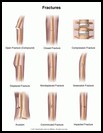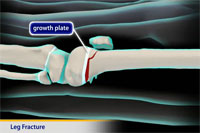
Broken Leg
What is a broken leg?
A leg fracture is a crack or break in one of bones of the leg. These include the femur (the large bone of the upper leg), the tibia (shin bone), or the fibula (calf bone).
Your child's bones are different than those of an adult. First, they are more flexible. Sometimes the bones crack like green branches from a live tree instead of snapping like a dry stick. Other times the bones just buckle slightly. The second major difference is that a child's bones are still growing from areas near the end of the bones called growth plates. Fractures in the growth plate can be difficult to see on the X-ray and they may affect the growth of the bone. Sometimes special tests are needed to diagnose fractures in this area.
What are the symptoms?
Symptoms of a broken leg include:
- severe pain
- inability to walk
- swelling
- a grating feeling when the leg is moved caused by the broken bones moving against each other
- muscle spasms
- an obvious deformity of the leg
How is it diagnosed?
Your child's healthcare provider will talk to you and your child about how the leg was injured, examine the leg and any other injured areas, and take an X-ray of the leg.
How is it treated?
The treatment for your child's broken leg depends on the type of break. Fractures may be treated with casts, splints, a removable boot, or an Aircast. Sometimes surgery is needed.
Your child may need to use crutches for several weeks after the injury.
How can I help take care of my child?
To reduce swelling keep the injured leg elevated on pillows when your child is resting. For the first day or two, put ice packs on the injured leg. Put the ice pack on for 10 minutes and then leave it off for at least 20 minutes before putting it on again.
Most cast material is not made to get wet. If your child needs a cast that can get wet, talk to your provider. Your child's provider will determine if the fracture may be safely treated with a waterproof cast.
Don't let your child scratch around or poke things down the cast as this may lead to an infection.
How long will the effects last?
Children tend to heal faster than adults, but healing times vary from one child to the next. As a rule most fractures heal in 4 to 6 weeks. Your child's provider may repeat X-rays to check on the pace of healing 2 or 3 weeks after the injury. If the bones are healing well your child may be able to put weight on the leg after a few weeks.
Depending on the type of injury and how it was treated, your child may need to do rehabilitation exercises. Most of the time pre-teen children are so active that they regain strength and flexibility without physical therapy.
When should I call my child's healthcare provider?
Call immediately or go to the emergency room if:
- Your child has increased pain, redness, warmth, or swelling.
- Your child has a loss of sensation in the leg or foot.
- The injured leg or foot looks pale, blue, or feels cold.


